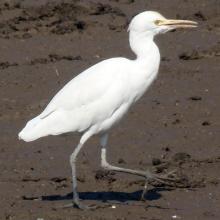Bubulcus ibis

Conservation Status:
Least Concern on the IUCN Red List.
Range:
Originally native to parts of Europe, Africa, and Asia, their range now spans North America, Asia, Africa, and Australia
Habitat:
They require a tropical or subtropical environment
Cattle egrets gather in large flocks throughout the year, whether it be a breeding colony or a nonbreeding roost. They forage in flocks in dry grasslands, often staying close to large herbivores such as cows, horses, or elephants. As these herbivores graze, insects are startled and take flight, providing an opportunity for cattle egrets to catch them. When near herbivores, cattle egrets are able to capture 30% more insects compared to when foraging alone. In addition to herbivores, tractors also startle insects, so cattle egrets sometimes follow tractors as well.
Male egrets establish and defend display territories, spreading their wings and performing courtship dances to attract the attention of females. Once paired up, the male and female defend a nesting territory together. They are monogamous within each breeding season. Cattle egret populations are increasing worldwide as they continue to expand into new areas.
